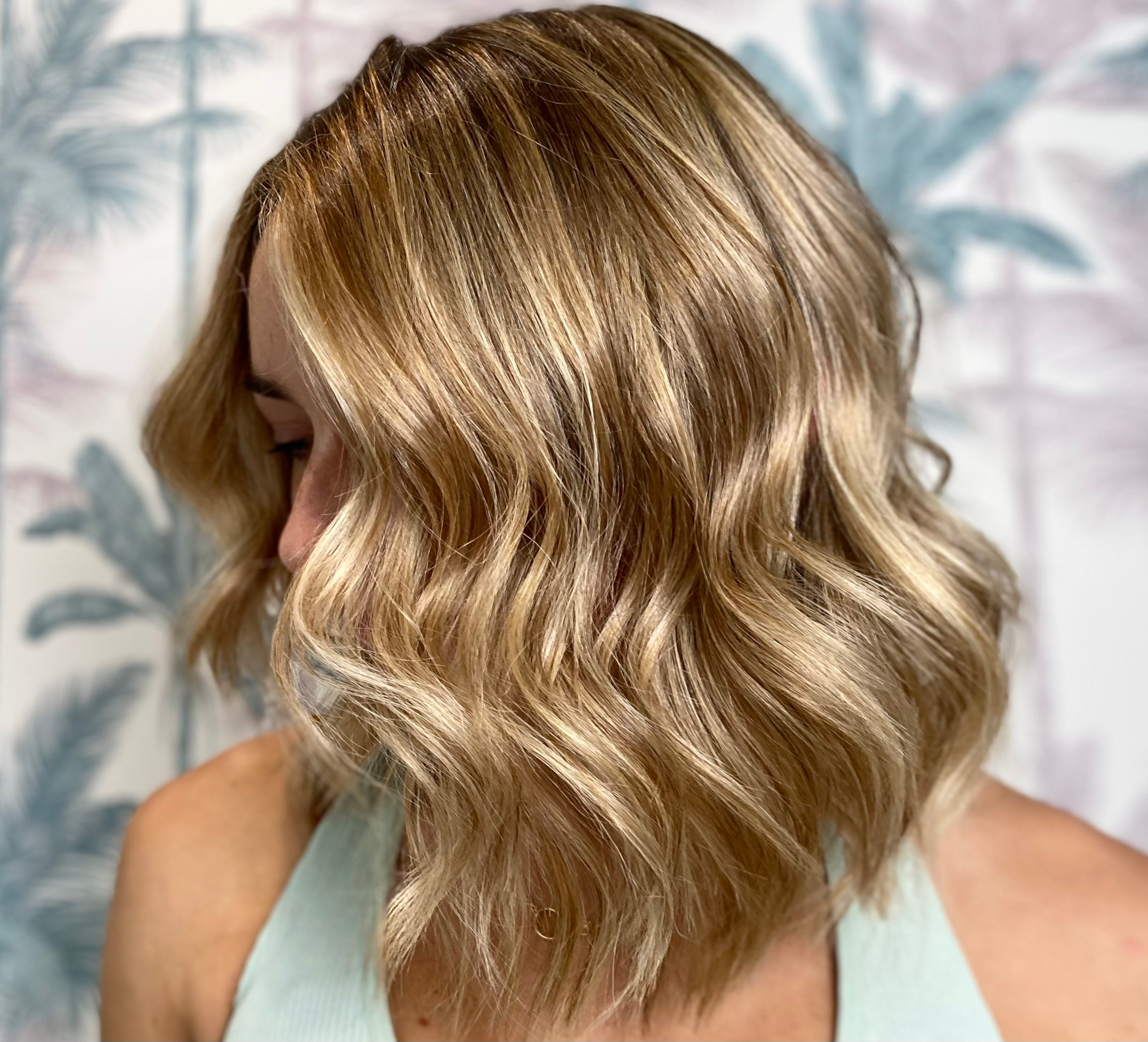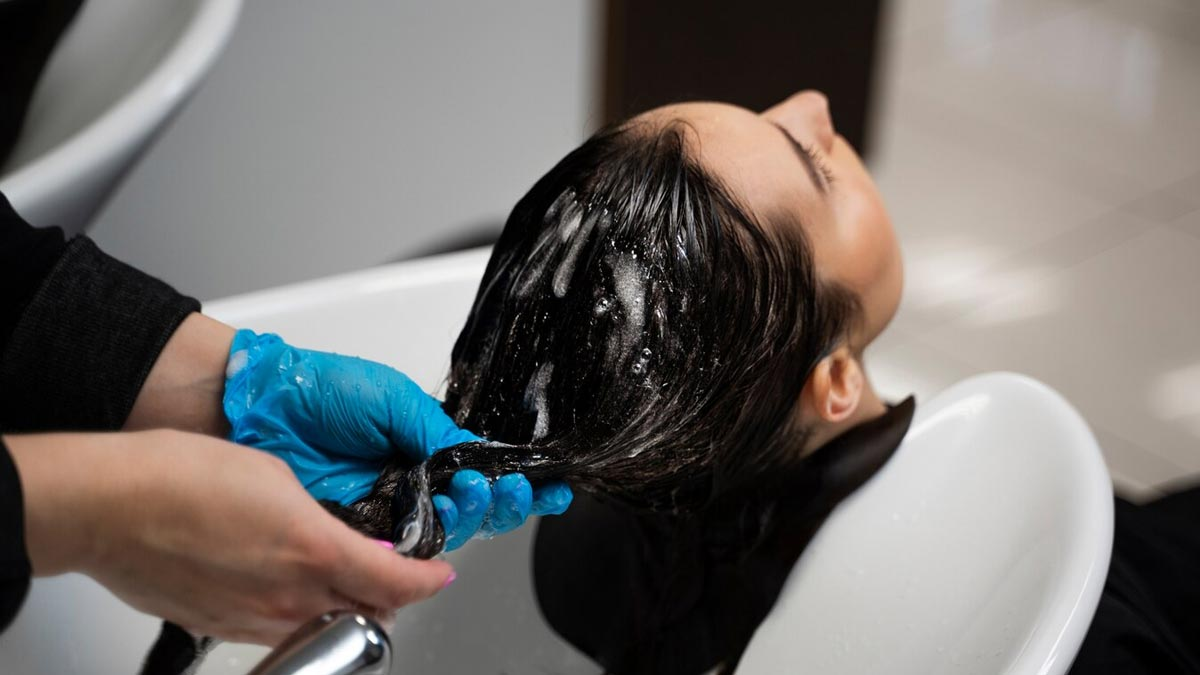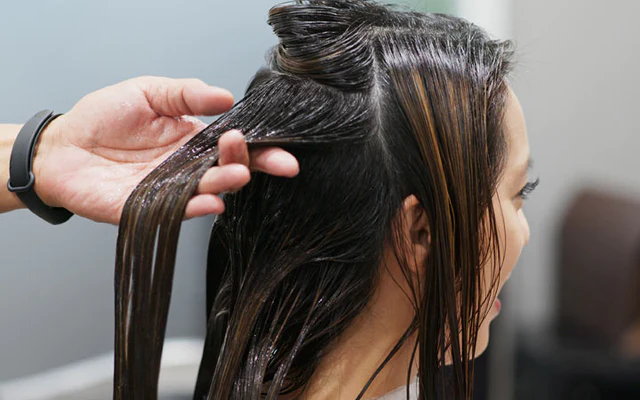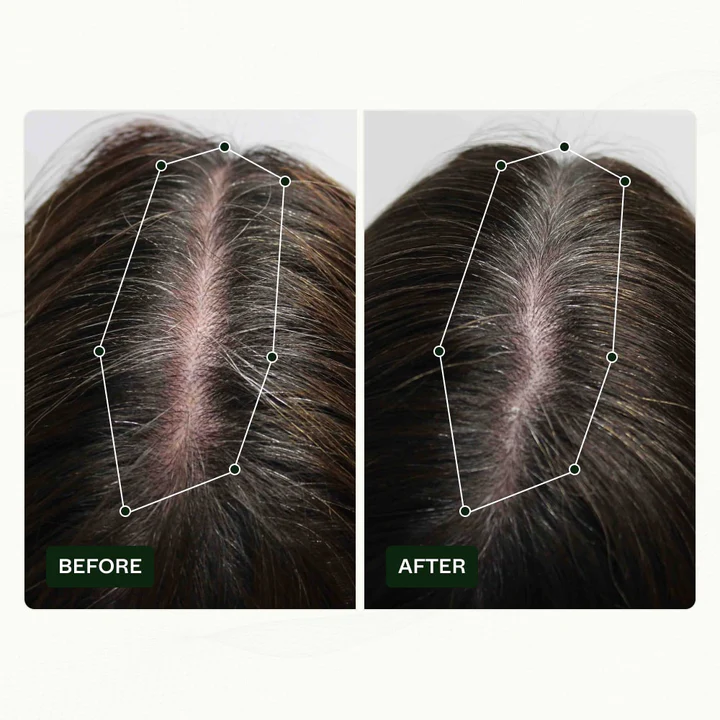Are you wondering if a keratin treatment is bad for your hair?
Discover everything you need to know about this popular hair-smoothing procedure, its benefits, potential drawbacks, and how it impacts your locks.
Get expert insights and tips to ensure your hair remains healthy and vibrant.
Table of content
What is keratin and what does it do for your hair?

Keratin is a type of protein naturally found in your hair, skin, and nails. It acts as a protective and structural component, helping to keep your hair strong, elastic, and resilient. When used in hair treatments, keratin can smooth down the cells that overlap to form your hair strands, resulting in hair that looks full, glossy, and smooth.
These treatments fill in the porosity of your hair, as overly porous hair can cause frizz, tangles, and breakage.
Keratin treatments can make managing a receding hairline, thinning hair, or hairstyles for thinning hair on the crown more manageable and easier to style, offering solutions to hide hair loss and create the appearance of thicker hair.
As your leading source for hair health information over the past 4 years, we never compromise on accuracy. When it comes to your health, you deserve information you can truly rely on - and earning your trust is our top priority.
Here's how Scandinavian Biolabs ensures every piece of content meets the highest standards of accuracy and integrity:
- Credentialed Experts: Our reviewers are actively practicing doctors and medical researchers
- Stringent Reviews: Content undergoes rigorous editing by subject specialists and review by a practicing doctor.
- Evidence-Based: We rely on well-established research from trusted scientific sources like peer-reviewed journals and health authorities.
- Full Transparency: Our editorial standards, writer credentials, reviewer credentials, correction process, and funding are all publicly documented.
- Independent Voice: While we do promote products, we operate in a vacuum to business operations. Our main goal is just an unwavering commitment to providing medically-sound guidance.
You can count on Scandinavian Biolabs to consistently deliver the trustworthy health information you deserve. Read our Editorial Standards.
Is keratin treatment bad for hair?

Salon keratin treatments are not inherently bad for hair, including thinning hair or male pattern baldness; they can offer significant benefits such as smoothing frizzy hair, reducing frizz, and enhancing manageability for healthier hair.
However, the safety and health effects depend on the treatment's formula and application process.
Some formaldehyde keratin treatments contain formaldehyde or formaldehyde-releasing chemicals, posing health risks during application and potentially leading to hair damage over time due to formaldehyde exposure, exacerbating conditions like male pattern hair loss, thin hair, and traction alopecia.
Can a keratin treatment help with hair growth?
A keratin hair treatment itself may not directly stimulate hair growth cycles, but it can contribute to a healthier scalp environment that supports the growth of existing hair and thicker hair.
By smoothing the hair shaft and reducing breakage, keratin treatments can help thin hair or hair thinning issues maintain its length, appear healthier, and achieve fuller, thicker hair.
This indirect benefit allows hair to grow longer and stronger over time, as it minimizes the damage that often leads to hair loss and breakage.
Moreover, keratin treatments can improve the overall manageability of natural hair or hairstyles for thinning hair on the crown, making it easier to detangle and style without causing damage or exacerbating hair loss.
For those struggling with frizz, tangles, or rough texture, this can mean less mechanical damage from brushing and styling, which is beneficial for hair health and can indirectly support hair growth.
What is the process of getting a keratin treatment?

Undergoing a keratin treatment is a comprehensive process that coats each hair strand with a protective layer of keratin, effectively smoothing and straightening the hair, even in thinning areas or balding crowns, promoting the appearance of longer hair and reducing the visibility of a receding hairline.
This treatment, which can last from 2 to 6 months depending on the hair type and how it's maintained, begins with a consultation where a professional stylist evaluates your hair type and condition to choose the most suitable keratin formula for your needs.
Following this, your hair is washed with a clarifying shampoo to eliminate any residues, ensuring the hair cuticles are open and ready to absorb the keratin solution effectively.
The keratin solution is then applied to either damp or dry hair, based on the specific instructions of the product being used, and is meticulously spread from the roots to the ends.
The wet hair, whether dealing with hairstyles for thinning hair or protecting longer hair lengths, must be saturated with the keratin solution for a set period, typically between 30 minutes to an hour, to fully absorb the benefits.
After this setting time, the hair is blow-dried and flat-ironed at a high temperature to seal the keratin into the cuticles, smoothing out the hair and securing the treatment.
Some keratin treatments may require the hair to be washed after a certain amount of time post-treatment, ranging from immediately to up to 72 hours, before it is finally styled.
The post-treatment care is vital for maintaining results and promoting healthy hair growth, including using sulfate-free shampoos and avoiding exposure to salt water and chlorine that could strip the treatment and affect hair follicles.
To enhance the results of your straightening routine, try one of these top-rated serums for hair straightening that deliver smoothness and shine without damage.
How long do keratin treatments last?
Keratin hair straightening treatments typically last between 2 and 6 months, depending on the hair type, the specific formula used, and the post-treatment care.
Proper care, including using sulfate-free shampoos and conditioners and minimizing exposure to salt water and chlorine, can extend the lifespan of the keratin treatments work, critical for maintaining hairstyles for thinning hair, combating male pattern baldness, and supporting hair transplants.
The longevity of a keratin treatment can also be influenced by how frequently the hair is washed, the natural texture of the hair, and environmental factors.
For example, those with very curly or coarse hair may notice the effects of the treatment diminishing sooner than individuals with finer or less curly hair.
Regular touch-ups and follow-up treatments can help maintain the desired effect, ensuring hair, from short hair to longer hairstyles, remains smooth, frizz-free, and easier to manage, which is crucial for hiding hair loss or managing a balding crown.
Types of keratin hair treatment
Chemical treatment options like keratin treatments offer a range of solutions tailored to different hair lengths and conditions, from frizzy hair to smooth finishes. Here are some popular types:
-
Brazilian Keratin: Ideal for extremely curly hair, lasts 3-6 months, and adds a protective protein layer without formaldehyde.
-
Soft Keratin: Targets fine to medium-textured curls for about two months, enhancing hair with a blow-dry and flat iron seal.
-
Japzilian Keratin: A hybrid of Brazilian Keratin and Japanese straightening, offering extended effects for up to 5 months, especially for rough and coarse hair.
-
Keratin Express: Best for wavy or straight hair, this treatment addresses frizz and dryness for up to six weeks.
-
Trisolla & Trisolla Plus Hair Treatment: Quick and effective for thick, curly hair, lasting 3-6 months, with easy maintenance.
-
Cezanne Hair Treatment: A natural, formaldehyde-conscious option that repairs and manages hair without being suitable for colored hair, lasting after a 30-minute application.
How to care for keratin-treated hair
Caring for keratin-treated hair, especially when dealing with male pattern hair loss or thinning areas, involves specific steps to maintain the treatment's effectiveness, extend its lifespan, and support the hair growth cycle.
Following the specific aftercare instructions provided by your stylist is crucial to extend the life of your keratin treatment, particularly for those with natural hair, loose hair prone to traction alopecia, or using hair ties on long hair, to ensure ongoing hair health and to treat hair loss effectively.
Here are key recommendations:
-
Use Sulfate-Free Shampoo and Conditioner: Sulfates can strip the keratin from your hair, so it's essential to use sulfate-free products to cleanse and condition your hair gently.
-
Wait Before Washing: After getting a keratin treatment, wait the recommended time before washing your hair—usually 2 to 3 days—to allow the treatment to fully set.
-
Avoid Salt Water and Chlorine: Salt water and chlorine can diminish the effects of the keratin treatment. Wear a swimming cap or apply a protective hair serum before swimming.
-
Minimize Heat Styling: High temperatures can break down the keratin coating on your hair. Use a heat protectant spray if you must use heat styling tools, and keep the temperature low.
-
Use a Silk Pillowcase: Sleeping on a silk pillowcase can help reduce friction and prevent frizz, keeping your hair smooth and extending the life of the treatment.
-
Limit Hair Washing: Washing your hair less frequently can preserve the keratin treatment longer. Aim to wash your hair only two to three times a week.
-
Avoid Harsh Chemicals: Hair dyes and other chemical treatments can affect the keratin in your hair. Consult with a professional before applying any chemicals to keratin-treated hair.
-
Use Leave-in Conditioner: A leave-in conditioner can add moisture and nourishment to your hair, helping to keep it smooth and manageable.
-
Regular Trims: Trimming your hair regularly can prevent split ends from worsening, which helps maintain the overall health and appearance of your keratin-treated hair.
A better approach for your overall hair health

The Bio-Pilixin Serum for men represents a cutting-edge approach to improving hair health, expertly formulated to combat hair loss and stimulate hair growth.
This innovative serum incorporates plant growth factors derived through advanced stem cell technology, aiming to nourish hair follicles and boost hair regeneration.
A key ingredient, Capilia Longa®, is a natural compound proven to significantly reduce hair loss—by up to 89%—and enhance hair density, with up to a 52% improvement observed in studies.
In addition to these growth factors, the serum is enriched with Niacinamide, a nutrient known for its ability to strengthen hair. It does so by promoting keratin production, which is crucial as keratin constitutes approximately 90% of the hair shaft, providing the structural integrity hair needs to thrive.
Another vital component, Vanillyl Butyl Ether, acts as a mild warming agent. This unique addition creates a warm, tingling sensation on the scalp, which is more than just comforting—it helps improve blood circulation.
Enhanced blood flow means more nutrients and oxygen are delivered to the scalp, fostering a healthier environment for hair follicles to flourish.
Together, these ingredients make Bio-Pilixin Serum a powerful ally in the quest for better hair health, offering a comprehensive solution to those seeking to reduce hair loss and encourage hair growth.
Conclusion
Keratin treatments offer a versatile solution for those seeking to combat frizz, enhance smoothness, and improve the manageability of their hair.
While not inherently bad for the hair, it's crucial to consider the specific formula and frequency of treatments to avoid potential damage, especially for those with fine or processed hair.
Keratin can support hair growth indirectly by reducing breakage and making hair easier to manage.
However, for those concerned about chemical exposure or seeking a more natural approach to hair health, products like Scandinavian Biolabs' Bio-Pilixin Serum present an innovative alternative.
Developed to reduce hair loss and support hair growth through plant growth factors, Niacinamide, and Vanillyl Butyl Ether, this serum nourishes the scalp and follicles for stronger, healthier hair.
Whether opting for a keratin treatment or exploring hair growth serums, the key to hair health lies in choosing the right products and treatments for your specific hair needs and following a dedicated care regimen to maintain your hair's health and vitality.
FAQs
Can keratin treatments damage your hair?
Yes, keratin treatments have the potential to make your hair dry, brittle, and prone to breakage due to the high heat and strong chemicals involved. This is especially true for individuals with fine or previously processed hair, whose strands may be more delicate.
Will keratin treatments ruin my natural hair texture?
Keratin treatments temporarily alter the structure of your hair to make it smoother and less frizzy, which can seem like a change in your natural texture. While they can repair damaged hair, overuse can lead to damage, affecting your hair's natural state over time.
Can hair loss occur after a keratin treatment?
Hair loss, known as Telogen Effluvium, can sometimes happen after chemical hair treatments like keratin. This condition is usually temporary, and hair should regrow naturally within three to six months if caused solely by the treatment.
References:
Read more:






